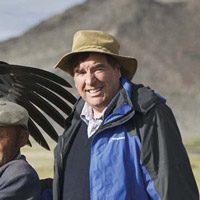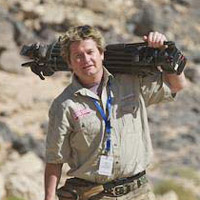


Philip Young is the driving force behind the Endurance Rally Association. As a boy Philip was inspired by Britain's post war rally achievements in the heyday of the British motor industry and avidly followed the exploits of the great rally teams depicted in films, like Shell’s highly evocative 1958 movie, “Coupe des Alpes” and books, such as the “Seven Year Twitch” by Marcus Chambers.
In the early 1980’s Philip was editing, writing for, and publishing his own motoring magazine, “Sporting Cars”, that twice won the premier award for journalism from the Guild of Motoring Writers. When the magazine was taken over by a large publishing group Philip was able to realise his ambition to organise an event in the style of the period he admired so much by organising an International rally specifically designed for the ever growing numbers of classic car owners.
Philip would fulfil his ambition with the first Pirelli Classic Marathon held in 1988 before going on to create a remarkable catalogue of more than 60 major international events, including three Peking to Paris events and the Round the World in 80 Days Motor Challenge which is the longest motor rally ever run. Early in 2012 Philip realised another long held ambition with the running of his London to Cape Town event.
In addition to organising events Philip is a past-competitor on many long-distance events, including the 1977 London to Sydney Marathon, Paris Dakar in 1986, and five Himalayan Rallies during the early 1980's and has driven as a works-team driver for Skoda, and the Unipart Rally Team in various Leyland cars including Triumph TR8 and Rover SD1. The Heritage Motor Museum at Gaydon exhibits two cars from his former escapades.
The formation of the Historic Rally Car Register was his inspiration and he is a co-founder of what is today the largest rally club in Britain with over 2,000 paid-up members. Philip was the creator and first editor of the club's acclaimed Oldstager magazine and is still a regular contributor.

Paul Brace is the Technical Director at Eagle E-Types, where he most recently designed and created the Eagle Speedster which quickly became Jeremy Clarkson's favorite car of all time - and still is.
In 1991 Paul emerged into Cameroon after being totally out of touch with the world for ten long days driving a Land Rover north through the dense jungle heart of central Congo on route-survey work, ...“a priceless experience”, Paul recalls. He has driven and filmed two Peking to Paris rallies, all the ERA World Cup rallies, including the recent London to Cape Town, and driven countless others including the Around the World in 80 Days.
He has extensive driving experience throughout the world but says of Africa; "It is the most alluring and magical continent and any chances to be there should be snatched with both hands".
He has successfully raced and rallied a wide variety of cars in a wide variety of events - an interest which started with the first ever Pirelli Classic Marathon in 1988. In 2005 Paul won the FIA Championship Historic Acropolis Rally outright driving a Porsche 911. "I only dipped in and out of motor-sport as I'm easily distracted by all the other high adrenaline and exciting things there are to be done in life. You only live once - and there is a lot of stuff to get in".
When Philip Young asked Paul if he wanted to join an attempt to smash the London to Cape Town World Record in a one-litre two-cylinder Fiat he instantly replied, "Of course I do!"
PARK ROYAL, NORTH LONDON - AUTUMN 2012
From the moment we turned the key, the Panda had us smiling. “Give it some revs... it sounds a bit like a V8” said the optimistic-sounding salesman, as we left Mellors of Wantage, and it’s only when you really crack the whip, and hear the growl of the willing engine, that you realise he has a point. In a world where all today’s small-cars look the same, perform much the same, and look as if they all come from the same computer programme – the Fiat Panda is refreshingly different. Voted the Top City Car by Autocar it’s not just us who think this car has a great engine, and excellent road-manners while providing sufficient entertainment that makes it a fun drive.
After collecting our World-Record challenger the first job was to change the engine oil for Comma running-in mineral oil. We drove very carefully on this for 600 miles - the first 300 miles was limited to 40 mph, keeping revs to a minimum, in order to ensure the piston-rings are run in and the bores nicely honed. Modern synthentic oils are just so good, and we wanted to ensure the rings were treated carefully to start off with. Then there was an oil change, to Comma mineral-oil 10-30 grade, for 1,000 miles, before changing to Red Line 10-40 synthetic. After clocking up about 2000 miles the car was delivered to the team at Tony Fowkes Automobiles where the brief is to keep as much as possible standard while placing car reliability and crew comfort at the top of the priority list..
From past experience we have chosen an extremely comfortable driver's seat taken from a very second hand Volvo 340. This has been covered in sheepskin sourced from Devon tanners Devonia of Buckfastleigh. Jackie from C.E. Moore, a specialist trimming company in the next street to Tony Fowkes Automobiles took on the job of covering the seats. Many years ago Rosemary Smith convinced us of this simple modification. Rosemary was sponsored by the International Wool Secretariat when she drove a works-Austin Maxi to 10th spot on the 1970 London to Mexico World Cup Rally, with seats covered in sheepskin, which Rosemary says is a major contribution in the fight against fatigue.... “cool in the heat, and cosy at night, it’s just what you need for days and nights at the wheel.”
Lack of sleep and extreme fatigue could wreck our plans so the rear of the car has been altered to make space for a thick mattress. The modified passenger seat will fold totally flat to form a full length bed with the rear mattress providing the co-driver the chance of some proper sleep.
To ward off the hot African sun we have lined the roof with "Thermawrap", a double layered lightweight insulating foil stuck to the roof behind the standard roof lining. Our Panda is running without air-conditioning but the front windows will get a pair of wind-deflectors, making it less draughty and more pleasant to drive along with the windows down, venting out at the back through our Mini Van roof vent sourced from MG specialists, Brown and Gammons of Baldock.
The interior gets a map light and other navigational essentials. There is talk of a caravan interior strip-light, and also some black curtain across the middle of the car.... so night stops by the driver won’t be too disturbing for the oh so exhausted co-driver, asleep in the back.
The build quality and general finish of the Panda has impressed Tony Fowkes' team but from our previous experience in Africa we know the suspension will be take a lot of punishment so certain work is essential although, compared to a purpose built rally-car, our preparation is minimal. This is a standard showroom-specification Fiat Panda, not a motor-sport special.
The ride height has been raised by fitting stronger and taller van tyres along with uprated springs and shock-absorbers. The suspension has been made by Gaz of Essex, and the rear shocks, which fit on the standard mountings, will soon be available to other Panda owners seeking uprated rear shocks. The front top mounts have been reinforced and a cross-bar now joins the struts along the top of the bulkhead. The rear shock abosrber mountings have been beefed up. The raised ride height has reduced negative-camber at the front and the first drive into the traffic of London’s North Circular Road, along with the taller, harder van rubber, makes the Panda driving experience “interesting” and something we now have to get used to. Space has been found for two spare wheels, one is upright on the passenger side at the rear of the car, the second lies fairly flat partly tucking under the driver’s seat.
The engine has been left totally standard, but gains a stout sump-guard of aircraft-quality alloy, as does the petrol tank. The exhaust is kept standard, but there are extra exhaust-hangers and kept as flexible as possible – the last thing we want is broken exhaust mountings by being insufficiently flexible. Brake and fuel lines are also protected. The engine bay is kept standard, but there is a spill proof battery from Odyssey, lighter and able to withstand all the vibration of the corrugations of rough African roads, this required a re-designed battery-tray from Roger Fowkes.
The original spare wheel space was too small for our larger van tyres but is now home to a neat alloy petrol tank, providing an extra 34 litres on top of the Fiat’s standard 40 litre tank. A larger than standard Monza petrol cap and larger fill pipe will be able receive old-fashioned and bigger petrol pump nozzles.
An extra bar across the front of the radiator behind the plastic nose-cone adds some extra front end protection and provides a secure fixing for a pair of PIAA spotlights. A couple of flashing yellow roof lights are also fitted. These lights and many other useful parts were sourced from Car Builder Solutions of Staplehurst, Kent. Check out their excellent parts catalogue www.nfauto.co.uk .
The top scuttle under the windscreen has been removed as this will allow more through-draft in the engine bay, hopefully. The catalogue of Car Builder Solutions also provided an air-vent and trunking which will be let into a front corner to shoot extra air directly onto the turbo, for a dose of added cooling. The radiator has been protected with gerbil-hutch wire-netting, there are polypropylene mudflaps to go on each corner, and the wheel-trims have been removed. The standard steel wheels are less brittle than alloys and dents can easily be tapped out. The bonnet gets a pair of bonnet pins, so there is no danger of severe vibration jamming the locking mechanism, which is now done away with.
David Williams and his team of exhibition graphic-designers at Genesis have offered to dress us up with a “wrap” of graphics. It will make the Panda stand out, they promise.... but given Pandas are such a rare sight in Africa, standing out on roads full of Toyotas ought not to be too much of a problem.
The car has spent many weeks in the workshop in Corby Road, and keeps on surprising the team. For example, in fitting a roof light, the drill broke in the first attempt to drill a hole through the roof.... the second drill-bit then had a go, and in a few seconds, became blunt. “This is very tough steel,” says Roger Fowkes. This is reassuring news, given it has to put up with everything Africa can throw at us.
Back to the top..